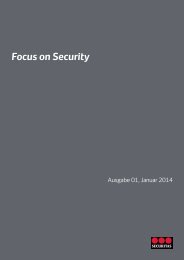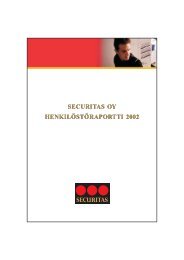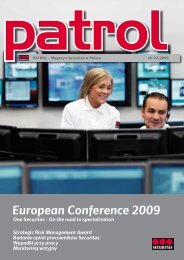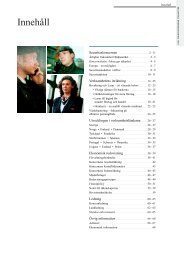SECURITAS AB Annual Report 2011
SECURITAS AB Annual Report 2011
SECURITAS AB Annual Report 2011
You also want an ePaper? Increase the reach of your titles
YUMPU automatically turns print PDFs into web optimized ePapers that Google loves.
80 <strong>Annual</strong> <strong>Report</strong><br />
Notes and comments to the consolidated financial statements<br />
Non-current assets held for sale and discontinued<br />
operations (IFRS 5)<br />
The Group applies IfRS 5 Non-current assets held for sale and discontinued<br />
operations, which sets out requirements for the classification, measurement<br />
and presentation of non-current assets held for sale and discontinued operations.<br />
According to IFRS 5 a non-current asset classified as held for sale or disposal<br />
group shall be measured at the lower of its carrying amount and fair<br />
value less cost to sell, if the carrying amount will be recovered through a<br />
sales transaction rather than through its continuous use in the operations.<br />
Measurement is carried out in two steps. First, all assets and liabilities are<br />
measured in accordance with the relevant standard. For disposal groups a<br />
second step also involves a re-measurement to the lower of the carrying<br />
amount and the fair value less cost to sell. A re-measurement should be<br />
carried out at each balance sheet date subsequent to the initial recognition.<br />
No depreciation or amortization should be recognized for these assets from<br />
the date of reclassification up until the disposal has been completed.<br />
A discontinued operation is a component of a group that represents a<br />
major line of business or geographical area of operations. The net income<br />
(after tax) relating to discontinued operations is included on a separate line,<br />
net income for the year, discontinued operations.<br />
Statement of cash flow (IAS 7)<br />
The statement of cash flow has been prepared in accordance with the<br />
indirect method. Liquid funds include short-term investments with a maximum<br />
duration of 90 days that are readily convertible to a known amount of<br />
cash and subject to an insignificant risk of change in value. Liquid funds also<br />
include cash and bank deposits.<br />
Goodwill and other acquisition related intangible assets<br />
(IFRS 3, IAS 36 and IAS 38)<br />
Goodwill represents the excess of the cost of an acquisition over the fair<br />
value of the Group’s share of the identifiable net assets of the acquired<br />
subsidiary /operations at the date of acquisition. Goodwill is tested annually<br />
for impairment and carried at cost less accumulated impairment losses.<br />
Gains and losses on the disposal of an entity include the carrying amount<br />
of goodwill relating to the entity or operations sold.<br />
Other acquisition related intangible assets arising from acquisitions can<br />
include various types of intangible assets such as marketing-related, customer-related,<br />
contract-related, brand-related and technology-based.<br />
Other acquisition related intangible assets normally have a definite useful<br />
life. These assets are recognized at fair value on the date of acquisition and<br />
subsequently carried at cost less accumulated amortization and any accumulated<br />
impairment losses. Amortization is calculated using the linear<br />
method to allocate the cost of assets over their estimated useful lives.<br />
Securitas’ acquisition related intangible assets mainly relate to customer<br />
contract portfolios and the related customer relationships. The valuation of<br />
the customer contract portfolios and the related customer relationships is<br />
based on the Multiple Excess Earnings Method (MEEM) which is a valuation<br />
model based on discounted cash flows. The valuation is based on the churn<br />
rates and profitability of the acquired portfolio at the time of the acquisition.<br />
In the model a specific charge – a contributory asset charge – is applied as a<br />
cost or return requirement for the assets supporting the intangible asset.<br />
Cash flows are discounted using the Weighted Average Cost of Capital<br />
(WACC) adjusted for local interest rate levels in the countries of acquisition.<br />
The useful life of customer contract portfolios and the related customer<br />
relationships are based on the churn rate of the acquired portfolio and are<br />
normally between 3 and 20 years corresponding to a yearly amortization<br />
of between 5 percent and 33.3 percent.<br />
Securitas <strong>Annual</strong> <strong>Report</strong> <strong>2011</strong><br />
A deferred tax liability is calculated at the local tax rate on the difference<br />
between the book value and tax value of the intangible asset. The deferred tax<br />
liability is reversed over the same period as the intangible asset is amortized,<br />
which means that it neutralizes the impact of the amortization of the intangible<br />
asset on the full tax rate percentage on the income after tax. The initial<br />
recognition of this deferred tax liability increases the amount of goodwill.<br />
Goodwill and other acquisition related intangible assets are allocated to<br />
cash-generating units (CGU) per country in a segment. This allocation is<br />
also the basis for the yearly impairment testing.<br />
The amortization of acquisition related intangible assets is shown on the<br />
line amortization of acquisition related intangible assets in the statement of<br />
income.<br />
Acquisition related restructuring and integration costs<br />
Acquisition related restructuring cost are costs relating to the restructuring<br />
and/or integration of acquired operations into the Group. Restructuring<br />
costs are costs that are recognized based on the specific criteria for restructuring<br />
provisions in IAS 37 (see further under the section Provisions below).<br />
Restructuring costs can cover several activities that are necessary to prepare<br />
acquired operations for integration into the Group such as redundancy<br />
payments, provisions for rented premises that will not be utilized or sublet<br />
below cost or other non-cancellable leasing contracts that will not be utilized.<br />
Integration costs normally cover activities that do not qualify to be recognized<br />
as provisions. Such activities could be re-branding (changing logotypes<br />
on buildings, vehicles, uniforms etc) but could also cover personnel<br />
costs for example training, recruitment, relocation and travel, certain customer<br />
related costs and other incremental costs to transform the acquired operation<br />
into the acquirers format. Classifying expenses as costs relating to integration<br />
of acquired operations must also fulfill the criteria below:<br />
· The cost would not have been incurred if the acquisition not had taken place<br />
· The cost relate to a project identified and controlled by management as<br />
part of a integration program set up at the time of acquisition or as a<br />
direct consequence of an immediate post-acquisition review.<br />
Items affecting comparability<br />
This item includes events and transactions with significant effects, which<br />
are relevant for understanding the financial performance when comparing<br />
income for the current period with previous periods. They include:<br />
· Capital gains and losses arising from the disposal of material cash<br />
generating units<br />
· Material impairment losses and bad debt losses<br />
· Material litigations and insurance claims<br />
· Other material income and expense items of a non-recurring nature<br />
Provisions, impairment losses, bad debt losses or other material non-recurring<br />
items that are classified as items affecting comparability in a period are<br />
accounted for consistently in future periods by treating any reversal of<br />
provisions, impairment losses, bad debt losses or other non-recurring items<br />
as items affecting comparability.<br />
The Group currently has no items affecting comparability in the income<br />
statement. Refer to note 11 for information regarding cash flow from items<br />
affecting comparability.

















